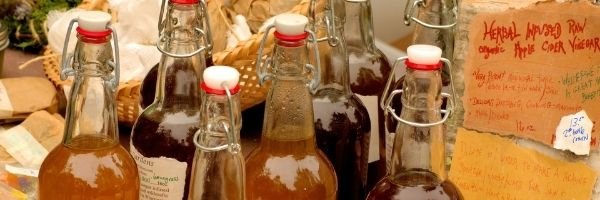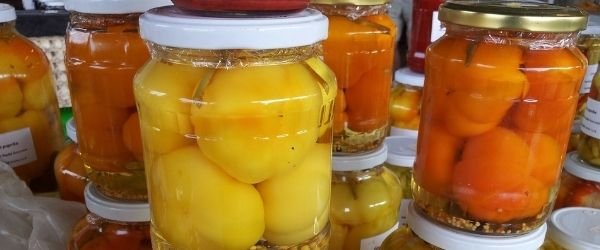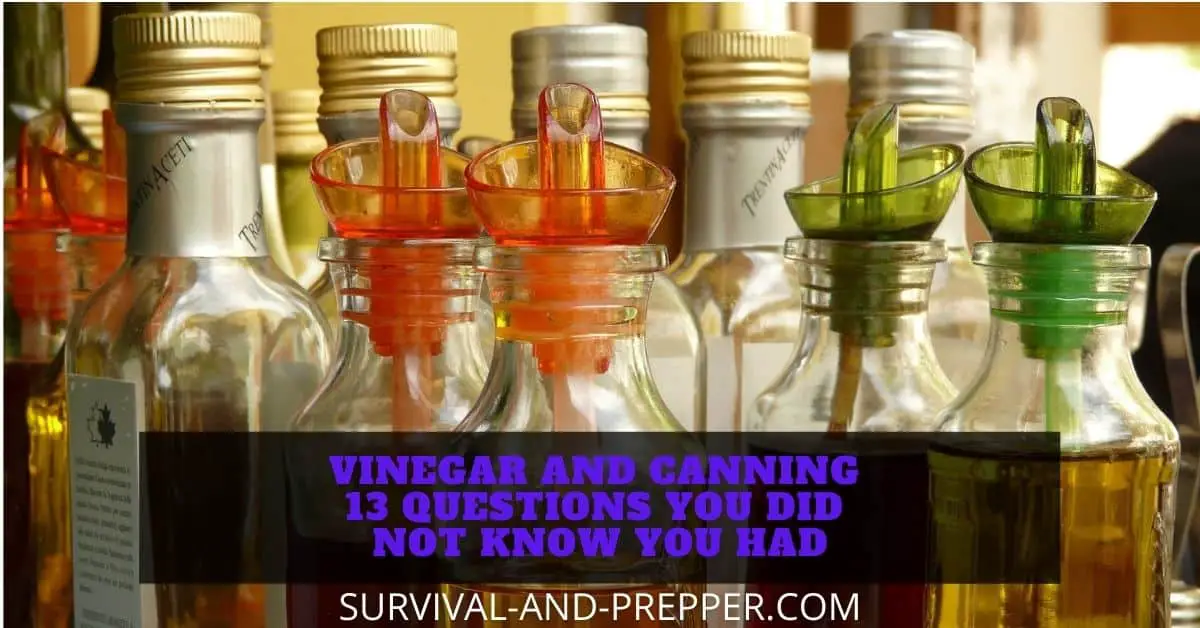Vinegar and Canning – 13 Questions You Did Not Know You Had
1. What does vinegar do in canning?
Vinegar is one of the main types of acid used during canning to lower the pH level of your liquid. This helps to control or eliminate the growth of bacteria and is required in many water bath recipes. Generally vinegar is added to reach a pH level below 4.60.
Vinegar, Water and pH
Vinegar with a mixture of 95% water and 5% acetic acid is the most common and is found in many stores as white vinegar. To reach an ideal mixture generally a ratio of 1 to 1 between water and vinegar is recommended and is the most common ratio in home canning.
Many will treat this as gospel and argue that anything less will result in the formulation of botulism. However, there is far more to it than just that.
You can verify your pH level yourself if you have a tester designed for this. However, for the purpose of this article we are going to refer to some testing done by healthycanning.com.
They first calibrated their pH tester, then tested plain water, plain vinegar and mixtures of 75%vinegar and 25% water, 50% vinegar and 50% water, as well as 25% vinegar and 75% water with the following results.
Plain water – pH of 7.0
Plain vinegar – pH of 2.6
75% vinegar & 25% water – pH of 2.49
50% vinegar & 50% water – pH of 2.60 (recommended mixture)
25% vinegar & 75% water – pH of 2.75
As you can see the vinegar is an excellent method of lowering the pH level of the water to a safe level for canning. When possible follow a scientifically approved recipe for canning but if you choose to tweak the ratios yourself then make sure to keep a 1 to 1 ratio of water and vinegar to stay well within the acceptable range.
2. How are canning vinegar and white vinegar different?
There is no significant difference in canning vinegar and white vinegar, in most cases they are nearly the exact same ratio of water and acetic acid to makeup the vinegar with the only difference being that canning or pickling vinegar has been mixed to exactly a 5% ratio.
Sometimes canning or pickling vinegar include spices but this is not frequently the case.
3. Is canning vinegar the same as white vinegar?
In most respects canning vinegar and white vinegar are the same, though when some people refer to it as canning vinegar they are indicating it has already been seasoned with the pickling spices and sugar needed for the specific recipe.
4. Can I substitute pickling vinegar for white vinegar?
Since there is no real difference in pickling vinegar vs white vinegar they can be used interchangeably. The only real factor that matters is the concentration of the acetic acid which should be around 5%. This concentration can be verified through a simple test with a pH meter.
It is important to verify the acidic level of the vinegar you are using. For instance the company Allen produces a pickling vinegar that is 7% acid by volume while many white vinegars are 5% in these cases you would need to adjust the amount just slightly to achieve the desired acidity in your final product. Just keep in mind that you need a pH level lower than 4.6.
5. Can you use white vinegar for canning?
In the US white vinegar is the most common vinegar used in canning recipes. It is made from a corn base and is generally at a concentrated rate of about 5%. Often the flavor profile is adjusted using various spices and amounts of water to dilute the acidity slightly.
6. Which vinegar is best for pickling?
In the US the most common vinegar is a white vinegar made from corn that has around a 5% concentration of acetic acid. This yields a clear brine and is cheap in bulk, however some people feel the taste is a bit overpowering, another option is apple cider vinegar which is more expensive and tends to color the brine a bit brown. Apple Cider vinegar has a milder and sweeter taste profile.
With whie vinegar and apple cider vinegar being the two most common types used you can use many other types as well. Another popular option is to use red or white wine vinegars, however I have not had experience with these and would suggest following a proven recipe if choosing to use one of those.
One other point of interest is that in the US it is common to add spices to your vinegar during the preparation stage, while in Europe it is common to find “spiced vinegars” that already have all of the pickling spices and such added.
7. What is added to make pickling vinegar?
Most US recipes call for the addition of either pickling spices or pickling lime. These consist of various salts and lime that are intended to both flavor and preserve the item being pickled. Oftentimes sugar and herbs are added to reach a desired flavor and is largely dependent on taste preference of the consumer.
Pickling lime is added to things such as tomatoes, cucumbers and peppers to ensure they maintain that crisp crunch that you expect when you eat a pickle.
Salt is added as a preservative and to provide some flavor.
Herbs such as parsley, tyme, and garlic will quickly alter the flavor profile to fit the intended use of the pickled products.
Sugar is added to reduce the tart taste imbued by the vinegar while not reducing the level of acidity. There is the added bonus of the sweeter taste when making certain dishes as well.
8. Can you make your own vinegar?

Vinegar can be made at home by fermenting a slightly alcoholic liquid. Apple cider, wines and grain alcohol are all options you could use. Place the material in a jar and cover with a porous cheese cloth. Allow this mixture to ferment for one to six months in a dark location with an average temperature of 60 to 80 degrees to produce your vinegar.
9. What is the desired pH level of Vinegar?
While there is no desired number, the normal pH of 5% vinegar is between 2.4 and 2.6 making it an acidic substance. When adding vinegar to your canning mixture you need a pH level below 4.6 to ensure that botulism does not form. The ratio of vinegar to water in order to stay below this is one part vinegar to one part water, though one part vinegar and 2 parts water is generally safe as well.
10. What kinds of vinegar can I use for canning?
When selecting a vinegar for canning you can use any type you prefer that fits the desired flavor profile. The most common ones in the US are white vinegar and apple cider vinegars, though wine based, balsamic and even rice vinegars can be used. The only concerning factor is to keep an eye on the pH level to ensure you stay below that 4.6 safety threshold.
If there are so many types of vinegars what are the differences and what would they be used for.
Here is a quick list of the main vinegars you are likely to encounter and what they could be used to can.
White Vinegar
White vinegar is made from fermenting corn. White vinegar is nearly clear and provides minimal flavor beyond the acidic bite. Because of this it is ideal to use when preserving fruits and vegetables that are light in color.
Apple Cider Vinegar
Apple cider vinegar is made from fermenting apples as its name would suggest. Many people feel that the cider adds more flavor and prefer to use it. However, its darker coloring can turn some people off if not paired with appropriate foods.
With that in mind, you can use apple cider vinegar in nearly any recipe that calls for white vinegar and vice versa. The apple cider vinegar tends to have somewhat less of a bite and makes an excellent choice when canning fruits such as apple slices, pears and even bread and butter pickles.
Red Wine Vinegar
Red wine vinegar is produced when wine made from red groups is further fermented. Red wine vinegar normally has around a 5 to 6% acidity making it an ideal option for canning.
However, it is not commonly used at least in the US but it is an option when you are preserving foods such as purple cabbage or beets among other things.
White Wine Vinegar
Having a slightly mellower taste than straight white vinegar white wine vinegar is made from wine produced by fermenting white grapes.
Due to its mellower taste white wine vinegar is normally used if at all when canning some light fruits such as peaches and pears.
Balsamic Vinegar
Producing balsamic vinegar is more complicated than some of the other vinegars. Several types of white grapes are first crushed into juice, boiled and reduced to a syrup.
This resulting syrup is then allowed to ferment for an extended time, often as much as 15 to 25 years. The end result is a dark red vinegar with sweet flavoring.
The unique flavoring of balsamic vinegar makes it ideal for use when canning fig and plum preserves among others.
You can also find a lighter “white” balsamic vinegar that can be used for lighter fruits if you do not wish to have the color affected by the dark red coloring of your common balsamic vinegar.
Rice Wine Vinegar
Rice wine vinegar is produced when rice is fermented into wine and then into rice vinegar. Often the sugar added during this process tends to make rice wine vinegar somewhat sticky, with a sweet taste.
I have never personally used rice vinegar for canning, though I was able to find recipes such as this pickled vegetables and others which used rice wine vinegar.
Malt Vinegar
Malt vinegar is yet another vinegar you might encounter. This is made from fermenting barley into a malt as if you were going to make ale. This is then fermented for several more months to produce a unique flavor and a dark mahogany colored liquid. Most often you see malt vinegar used on fried dishes such as fish and chips.
Though if color is not a concern you can make some unique pickled dishes using malt vinegar. The two I can think of off hand are English pickled onions and beets. Eggs and dilly beans are additional options.

11. What is the ratio of water to vinegar for pickles?
The most common ratio of vinegar to water when canning pickles is one part vinegar to one part water. However, many recipes call for a 1 part vinegar to 2 parts water and there is no real danger in this change. Based on some testing, anything higher than a 1 part vinegar to 3 parts of water is safe, however most err on the side of caution sticking to 1 part vinegar to 2 parts water just to be sure.
Find a proven recipe and follow that in regards to your ratios though, this will ensure that you are not skirting the dangers of botulism. There are dozens that you can choose from to adjust for your desired tastes. Sites such as FreshPreserving and the National Center for Home Food offer access to recipes.
You can even find a downloadable PDF from the National Center for Home Food titled “Complete Guide to Home Canning (2015)” here.
12. Should I boil vinegar before canning?
When using store bought vinegar it is not normally necessary to boil the vinegar prior to canning, however some recipes will require that you boil all of the ingredients prior to placing them in your jar. If you are using homemade vinegar then yes it needs to be filtered and boiled prior. Additionally you need to test the pH to ensure it is below 4.6.
(Many sources recommend you don’t use homemade vinegar since it is difficult to verify the acidity levels. However, with a pH tester you can verify that it just takes a bit more work.)
13. How can I check the pH of vinegar?
The pH of vinegar can be checked in several ways, many manufacturers list the strength right on the bottle, you can also check the pH levels using an electronic meter, test strips or reactive dyes.
An electronic meter such as the Dr. Meter pH Tester can be used to test the acidity of nearly any liquid. It has an accuracy range of within 0.01pH. The use of this will help to guarantee that you will be within safe limits if showing well below the 4.6 pH.
The main drawback to these types of testers is that they need to be calibrated periodically, though this is a relatively simple task that the user manual details how to perform.
Test strips such as the Instant Read pH Strips work by turning a particular shade based on the acidity of the liquid they are submerged into. These can be semi accurate, however there is always a bit of color variance when attempting to read them. I suggest these when you need a rough reading but are well below the 4.5 threshold.
Reactive dyes are the last method we are going to discuss here. The AO2 Water pH tester is an example of one of these. In my opinion these are best left alone as it is difficult to get an exact reading, they again leave the decision up to your interpretation of color and how much liquid was used. Ok for fish tanks etc, not so much for food.
Given the three options above, I prefer an electronic meter; however, test strips are safe enough especially if you err on the side of caution and aim for a mixture around the 3.5 pH range.
14. How can I raise the pH of vinegar?
Raising the pH of vinegar can be done in several ways, the most obvious is concentrating it. This involves boiling some of the water off leaving behind the vinegar. You can also add lemon juice which has a higher acidity than vinegar and is still food safe. The final method is adding a higher concentration of vinegar.
For example while most vinegars are 5%, there are some varieties that come in strengths of 7% or more and even some concentrates that are as much as 25% acetic acid.
15. How can I lower the pH of vinegar?
Lowering the pH of vinegar can be done in two ways. Either add water to dilute it or an alkaline solution to counteract part of the acidity, an example of this is baking soda which is an alkaline and counteracts vinegar.
Water has a pH of 7.0 and is considered a neutral. When you add that to vinegar will begin to dilute the vinegar and raise the pH of the mixture.
In Conclusion
Hopefully you found the answer to at least one of your questions here. If you did make sure and share this article to your canning facebook groups and other message boards so someone else can use the information as well.


![A Detailed Review of the Ball Electric Canner [FreshTECH]](https://survival-and-prepper.com/wp-content/uploads/Ball-Electric-Canner-1-768x402.jpg)
![Heat and Your Mason Jars [ 9 ] Top Questions & The Answers](https://survival-and-prepper.com/wp-content/uploads/heat-and-mason-jars-768x402.jpg)

![Hot Pack Canning vs Cold Pack Canning [What’s the Difference]](https://survival-and-prepper.com/wp-content/uploads/2021/03/Hotpack-v-cold-pack-768x402.jpg)
